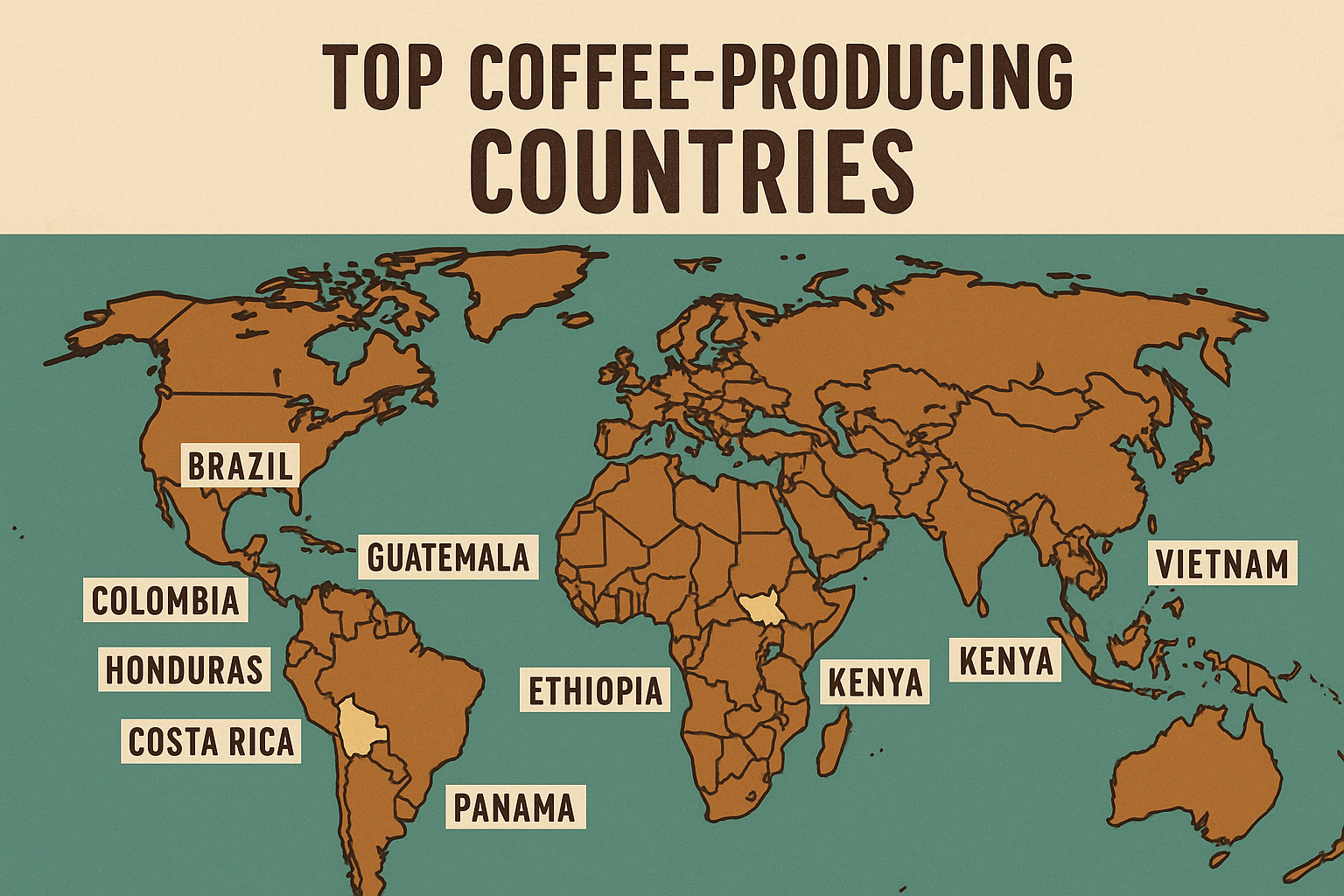Coffee is cultivated in more than 70 countries worldwide, but only a few stand out as global leaders in quality, volume, and unique flavor profiles.
Each coffee-producing nation brings its own climate, altitude, processing methods, and cultural heritage to the beans it exports. In this article, we’ll explore the most important coffee-producing countries in the world, what makes their coffee distinct, and why these origins matter for your cup.
Why Origin Matters in Coffee
The origin of a coffee bean plays a fundamental role in its flavor. This is due to factors like:
- Climate and altitude
- Soil composition
- Cultivation practices
- Post-harvest processing methods
These elements, collectively known as terroir, influence everything from acidity and sweetness to body and aroma. That’s why coffee from Ethiopia can taste fruity and floral, while coffee from Brazil might lean toward chocolatey and nutty.
Understanding where your coffee comes from helps you appreciate the complexities of each cup and allows you to choose beans that match your flavor preferences.
1. Brazil – The Giant of Global Coffee
- Region highlights: Minas Gerais, São Paulo, Espírito Santo
- Flavor profile: Chocolatey, nutty, low acidity, creamy body
Brazil is the largest coffee producer in the world, accounting for roughly one-third of global production. With vast plantations, mechanical harvesting, and a well-developed infrastructure, Brazil dominates both the commercial and specialty markets.
Brazilian beans are known for their consistency and approachable flavor—perfect for espresso blends and base notes in coffee blends. Natural (dry) processing is common, enhancing sweetness and body.
2. Colombia – Balanced and Beloved
- Region highlights: Antioquia, Huila, Nariño
- Flavor profile: Caramel, red fruits, citrus, balanced acidity
Colombia is synonymous with high-quality Arabica coffee. Thanks to the Andes Mountains, the country offers ideal growing conditions—high altitude, volcanic soil, and steady rainfall.
Colombian coffee is typically washed, which gives it a clean, bright profile. It’s a favorite for drinkers who enjoy a smooth and balanced cup. The country also invests heavily in coffee research, quality control, and branding.
3. Ethiopia – The Birthplace of Coffee
- Region highlights: Yirgacheffe, Sidamo, Harrar
- Flavor profile: Floral, citrus, jasmine, blueberry, tea-like body
Ethiopia is often considered the spiritual home of coffee. It’s where Arabica coffee originates, and the country still cultivates wild, heirloom varietals that aren’t grown anywhere else in the world.
Ethiopian coffees are some of the most complex and aromatic, prized in the specialty world. Natural and washed processing methods yield drastically different flavor profiles, from bright and floral to deep and wine-like.
4. Vietnam – Robusta Powerhouse
- Region highlights: Central Highlands (Lam Dong, Dak Lak)
- Flavor profile: Bold, earthy, chocolaty, low acidity
Vietnam is the second-largest coffee producer in the world, and the largest exporter of Robusta beans, which are stronger and more bitter than Arabica.
Vietnamese coffee is essential in instant coffee production and commercial blends. It’s also central to local culture—cà phê sữa đá, a strong iced coffee with sweetened condensed milk, is iconic.
While Arabica production is increasing in Vietnam, the country remains rooted in Robusta farming with a growing emphasis on specialty-grade Robusta.
5. Honduras – Rising Star of Central America
- Region highlights: Santa Bárbara, Copán, La Paz
- Flavor profile: Sweet, nutty, tropical fruits, medium acidity
Honduras has emerged as a major player in the specialty coffee scene over the past two decades. Once overshadowed by its neighbors, the country now produces award-winning coffees thanks to improved infrastructure and farmer education.
The diverse microclimates and elevations make Honduras an exciting origin, offering a wide range of profiles from chocolaty and sweet to bright and fruity.
6. Kenya – Bright, Juicy, and Complex
- Region highlights: Nyeri, Kirinyaga, Embu
- Flavor profile: Blackcurrant, grapefruit, floral, high acidity
Kenyan coffee is renowned for its bold acidity and fruit-forward flavors. The country uses a unique double fermentation method, which contributes to its signature taste.
Kenyan beans are often auctioned at high prices in specialty markets, and their cup quality is consistently high. These coffees are perfect for pour-over methods that highlight their clarity and complexity.
7. Guatemala – Volcanic and Vibrant
- Region highlights: Antigua, Huehuetenango, Cobán
- Flavor profile: Cocoa, spice, floral, full-bodied
Guatemala’s volcanic soils and varied altitudes make it a favorite for specialty coffee lovers. Regions like Antigua produce rich, full-bodied coffees with notes of cocoa and spice, while Huehuetenango offers bright, fruity, and floral cups.
Guatemalan coffee is mostly washed and comes from small, family-owned farms. Its wide range of profiles makes it versatile and appealing to many palates.
8. Panama – Small Country, Big Flavor
- Region highlights: Boquete, Volcán, Renacimiento
- Flavor profile: Floral, tropical fruit, tea-like, silky body
Though small in volume, Panama produces some of the most expensive and rare coffees in the world, especially the famous Geisha varietal.
Geisha from Panama is known for its explosive floral aroma, delicate acidity, and tropical fruit notes. These beans regularly win international competitions and fetch record prices at auction.
9. Costa Rica – Pioneers in Processing Innovation
- Region highlights: Tarrazú, West Valley, Central Valley
- Flavor profile: Bright, citrusy, clean, crisp
Costa Rica is known for its sustainable farming practices and innovation in coffee processing. The honey process, which leaves some fruit mucilage on the beans while drying, originated here and produces a balanced, sweet cup.
The country’s tight regulations on quality control and its reputation for clean, bright coffees make Costa Rica a favorite in the specialty market.
10. Yemen – Ancient and Rare
- Region highlights: Haraz, Ibb, Al-Mahwit
- Flavor profile: Spicy, wine-like, dried fruit, rustic
Yemen has been growing coffee since the 15th century, and it was the original exporter of beans through the port of Mocha (which later gave its name to the mocha coffee drink).
Yemeni coffee is unique due to its heirloom varietals and dry processing methods. Production is small and often done in terraced mountain farms without modern machinery, resulting in rustic but incredibly complex flavors.
Why It’s Worth Exploring Different Origins
Trying coffees from different countries helps you develop a more nuanced palate. It also deepens your appreciation for the skill and effort behind each origin’s production. Whether you prefer fruity, floral, nutty, or chocolaty profiles, there’s a producing country that aligns with your taste.
Rotating between origins allows you to:
- Compare flavor profiles directly
- Support a wider range of farmers
- Learn about processing techniques and farming culture
- Avoid palate fatigue from drinking the same type of coffee every day
Final Brew: Celebrating Global Diversity Through Coffee
Each coffee-producing country brings something special to the table. From the sweet fruitiness of Ethiopian Yirgacheffe to the comforting nuttiness of Brazilian Santos, the world of coffee is as diverse as the people who drink it.
By learning more about where your coffee comes from, you’re not just becoming a more informed consumer—you’re connecting with cultures, supporting global agriculture, and honoring the rich legacy behind every bean.

Marcelo Oliveira is a coffee enthusiast and content creator specializing in barista skills, brewing methods, equipment reviews, coffee-related health insights, and fascinating curiosities from the coffee world. With a deep passion for every step of the brewing process, he turns technical knowledge into accessible and engaging content for both beginners and seasoned coffee lovers. Marcelo’s goal is to help readers appreciate the full experience of coffee—from bean to cup.
